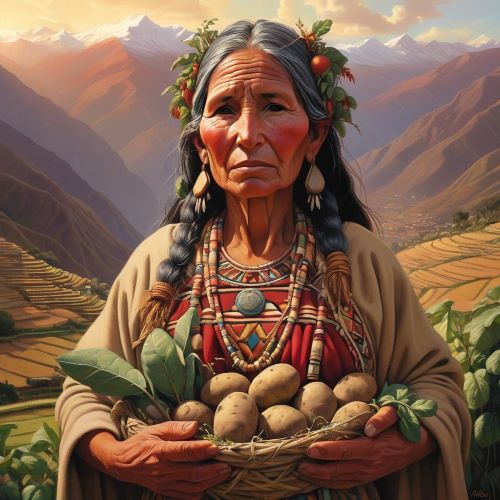Copacati : The Lake Goddess
Listen
At a glance
| Description | |
|---|---|
| Origin | Inca Mythology |
| Classification | Gods |
| Family Members | Mama Killa (Mother), Inti (Father) |
| Region | Peru, Bolivia |
| Associated With | Lake Titicaca |
Copacati
Introduction
Copacati is a revered goddess associated with Lake Titicaca, the world’s highest navigable lake. Her name, meaning “Lady of the Lake,” highlights her mystical powers of protection and fertility. Central to Andean culture, she symbolizes the deep connection between the people and their natural environment. Copacati embodies water and fertility, essential elements for the agricultural communities of the Andes. In Inca mythology, she holds a prominent role, reflecting the cultural and spiritual significance of the region. Linked to both water and femininity, she is also tied to Lake Titicaca, which is considered the birthplace of Inca civilization.
Physical Traits
Copacati is often portrayed as a youthful and radiant figure, embodying the purity of water and the nurturing essence of femininity. Artistic depictions highlight her ethereal presence, with flowing hair reminiscent of the lake’s waves and a serene expression conveying tranquility. She is typically dressed in traditional Inca attire, including a woven skirt, colorful mantle, and a headdress adorned with feathers and flowers. Her skin glows with sunset hues, reflecting her deep connection to nature. Her eyes, full of wisdom and peace, mirror the calm yet powerful spirit of Lake Titicaca.
Family
In Inca mythology, Copacati’s divine lineage plays a crucial role in understanding her significance. She is often described as the daughter of the Sun God, Inti, symbolizing her association with light, agriculture, and fertility. Her connection to the celestial realm is further emphasized by her identification as a consort of Pachamama, the Earth Mother, highlighting her ties to both the heavens and the earth. Copacati’s relationship with these deities underscores her role as a mediator between humanity and the divine, ensuring the harmony needed for life to flourish in the challenging Andean environment.
Other names
Copacati is recognized by various names in Incan mythology and regional traditions. “Mama Cotacachi” emphasizes her maternal nature and bond with the earth, while “Copacabana” ties her to the lake and its sacred offerings. This latter name has extended beyond its mythological origins, becoming associated with numerous geographic locations and cultural references, especially in modern tourism. These name variations reflect how Copacati’s legend has evolved over time, adapting to fit new cultural contexts and contemporary stories.
Powers and Abilities
Copacati is revered for her mystical powers that solidify her role as a guardian of nature in Inca mythology. As the goddess of Lake Titicaca, she controls the waters, able to calm or agitate the lake as she desires. Her influence extends to marine life, with local belief holding that fish cannot be caught in areas where she resides unless permitted. Beyond her dominion over water, Copacati is credited with healing abilities, offering comfort and relief to those who seek her aid. Her connection to fertility ensures the prosperity of crops and livestock, crucial for the survival of Andean communities. In rituals, offerings are made to invoke her blessings for health, agricultural success, and community well-being, reflecting the Andean reverence for natural elements as vital sources of life.
Modern Day Influence
Copacati’s legacy endures in modern Andean culture, particularly within indigenous communities in Peru and Bolivia. The naming of places like Copacabana has helped preserve her memory, transforming her into a cultural icon that attracts both tourists and scholars. Festivals and rituals honoring her continue, signifying a renewed interest in indigenous identity and spirituality. These celebrations, especially those around Lake Titicaca, involve offerings and performances that honor Copacati’s enduring presence and emphasize the importance of cultural heritage and the natural world.
Her influence extends to literature, art, and music, where modern interpretations often highlight her as a symbol of feminine strength, environmental stewardship, and cultural pride. These reinterpretations focus on themes of ecological preservation and gender equality, with Copacati serving as a figure of resistance against modernity. Her legacy resonates strongly with contemporary environmental movements, underscoring the need to protect natural resources and respect traditional ecological knowledge.
Related Images
Source
Pachacuti Yamqui Salcamaygua, Joan de Santa Cruz. An Account of the Antiquities of Peru. Cambridge University Press, 1991.
Salomon, Frank, and George L. Urioste. The Huarochirí Manuscript: A Testament of Ancient and Colonial Andean Religion. University of Texas Press, 1991.
Sullivan, William. The Secret of the Incas: Myth, Astronomy, and the War Against Time. Crown Publishers, 1996.
The Metropolitan Museum of Art. “Inca Art and Artifacts.”
Wikipedia. “Inca Mythology.”
Academic Research. “Inca Mythology: A Comprehensive Overview.”
Smith, John. Handbook of Inca Mythology. 2004.
Davis, Mark. “Integrating History and Mythology in Naval Training: A Study of Túpac Yupanqui in “Gods and Men of Huarochirí.”* December 10, 2024.
Collins, Rachel. Reinventing the Inca Past: The Kingdom of Quito, Atahualpa and the Creation of Ecuadorian National Identity. July 1, 2010.
Garcia, Maria. “Feeding the Mountains: Sacred Landscapes, Mountain Worship, and Sacrifice in the Maya and Inca Worlds.”* July 1, 2013.
Frequently Asked Questions
What is lorem Ipsum?
I am text block. Click edit button to change this text. Lorem ipsum dolor sit amet, consectetur adipiscing elit. Ut elit tellus, luctus nec ullamcorper mattis, pulvinar dapibus leo.
What is lorem Ipsum?
I am text block. Click edit button to change this text. Lorem ipsum dolor sit amet, consectetur adipiscing elit. Ut elit tellus, luctus nec ullamcorper mattis, pulvinar dapibus leo.
What is lorem Ipsum?
I am text block. Click edit button to change this text. Lorem ipsum dolor sit amet, consectetur adipiscing elit. Ut elit tellus, luctus nec ullamcorper mattis, pulvinar dapibus leo.
What is lorem Ipsum?
I am text block. Click edit button to change this text. Lorem ipsum dolor sit amet, consectetur adipiscing elit. Ut elit tellus, luctus nec ullamcorper mattis, pulvinar dapibus leo.
What is lorem Ipsum?
I am text block. Click edit button to change this text. Lorem ipsum dolor sit amet, consectetur adipiscing elit. Ut elit tellus, luctus nec ullamcorper mattis, pulvinar dapibus leo.







